Hair loss
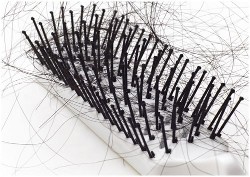 Alopecia is a symptom of disease consisting in the progressive disappearance of hair production in the hair follicle. This process applies mainly to the hair on the head, although not all areas of the head are susceptible to its equally. Alopecia may be the result of skin disorders of the scalp or systemic disorders with a variety of substrates. Hair loss is a huge psychological problem and proper diagnosis of its cause allows you to take appropriate treatment.
Alopecia is a symptom of disease consisting in the progressive disappearance of hair production in the hair follicle. This process applies mainly to the hair on the head, although not all areas of the head are susceptible to its equally. Alopecia may be the result of skin disorders of the scalp or systemic disorders with a variety of substrates. Hair loss is a huge psychological problem and proper diagnosis of its cause allows you to take appropriate treatment.
Causes of alopecia:
1) mechanical - hair-pulling hairstyles (horse's tail), hair-pulling (trichotillomania),
2) toxic - poisoning with metals (thallium, arsenic, mercury),
3) severe acute diseases, infections, high fever,
4) chronic diseases: connective tissue diseases, chronic infections, malignant tumors,
5) drug-related:
- cytostatics and immunosuppressive drugs (cyclophosphamide, methotrexate),
- antithyroid,
- anticoagulant,
- antihypertensive: beta-blockers, ACE-inhibitors,
- lipid lowering,
- non-steroidal anti-inflammatory drugs,
- others: cimetidine, retinoids, amphetamines,
6) hormonal disorders:
- hyperprolactinemia (especially in connection with "late" acne),
- Addison's disease,
- Hashimoto type thyroiditis,
- hyperandrogenemia or hypersensitivity of the hair follicles to androgens,
7) abnormal absorption and inflammatory diseases of the intestines,
8) hair diseases (e.g., mycosis) or hairy skin (e.g. seborrheic dermatitis),
9) others: stress, puerperium, trauma, general anesthesia, discontinuation of hormonal contraception;
Factors considered in the diagnosis of balding:
1) Hair washing - everyday washing with a mild shampoo is acceptable and does not cause increased hair loss,
2) Cosmetics:
- haircut, coloring with gentle shampoos, hairsprays are harmless,
- aggressive permings, frequent drying destroy hair roots, may disturb hair growth,
3) Diet:
- drastic weight loss causes telogen hair loss,
- low iron levels increase the sensitivity of the hair follicles to androgenic hormones,
- biotin and zinc deficiencies are rare and do not play a significant role in the process of baldness, however their supplementation may be helpful (eg zinc is a cofactor of important enzymatic processes);
Diagnostics (often targeted after gathering an accurate interview):
1) Laboratory tests:
- blood counts, iron and ferritin levels,
- thyroid functioning: TSH, antithyroid antibodies: anti-TPO, anti-Tg,
- hormonal tests: prolactin (PRL), testosterone, dehydroepiandrosterone (DHEAS), sex hormone binding globulin (SHBG);
2) Quantitative and qualitative assessment of hair:
Trichoskopia - It is a digital method of hair examination based on the technique of videodermoscopy. The FotoFinder video photodermatoscope is used for the examination. The camera receives the image on a computer monitor. 20x and 70x magnification are most commonly used. In trichoscopy, the hair stems, hair follicles and the surrounding skin are evaluated. The Laser-Medica Center uses two hair trichromatic evaluation techniques
1) TrichoLAB - hair analysis performed by a specialized laboratory based on known algorithms. The algorithms and calculation methods used in TrichoLAB are constantly improved, and the experience gathered with each performed research translates into ever-greater precision of operation. The method does not require collecting or shaving the hair, which makes the study significantly more comfortable compared to trichogram and trichoscane.
Thanks to the fact that the examination is non-invasive and painless, it is much easier to decide on its re-performance when assessing the effectiveness of the treatment.

Tenor of procedure: :
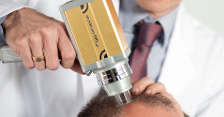 During the examination with the help of the camera an image of hair and scalp is obtained in three areas: frontal, temporal and occipital. In each location, the doctor takes 4 photos. Depending on the conditions and clinical suspicion, the test is performed with or without fluid ("dry"). The pictures are then subjected to automatic computer analysis of the image. Advanced algorithms for recognizing specific color-spatial combinations (pattern recognition) allow you to automatically detect and accurately measure hair, hair units (bellows) and other important objects in the pictures. Detailed data on hair and hair units are then used to calculate key statistical indicators of the trichomical method.
During the examination with the help of the camera an image of hair and scalp is obtained in three areas: frontal, temporal and occipital. In each location, the doctor takes 4 photos. Depending on the conditions and clinical suspicion, the test is performed with or without fluid ("dry"). The pictures are then subjected to automatic computer analysis of the image. Advanced algorithms for recognizing specific color-spatial combinations (pattern recognition) allow you to automatically detect and accurately measure hair, hair units (bellows) and other important objects in the pictures. Detailed data on hair and hair units are then used to calculate key statistical indicators of the trichomical method.


This study allows an objective assessment of the effectiveness of the therapy, which in many cases is very important for the patient due to the psychosomatic dimension of many dermatoses of the scalp's skin.
2) Trichoscan - video broadodermatoscope software for digital assessment of hair growth and loss. It automatically calculates the amount of hair, density and ratio of anagen to telogen hair. Trichoscan is a method that combines epiluminescence microscopy with digital image analysis. It allows the percentage of hair to be determined in the anagen and telogen phases. Trichoscan is a modified version of the traditional trichogram.
Tenor of procedure: :
1) 3 days before the examination, shave the hair on the surface of 1 in the area of their increased loss.
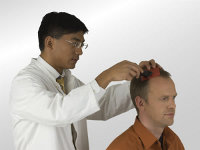
2) 15 min. before the test, the shaved skin is lubricated with a special test substance.
3) A videodermatoscope camera is attached to the skin.
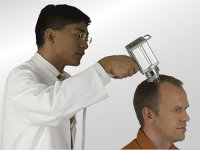
4) On the computer screen we get an image with a magnification of 20-70x. The computer analyzes the hair parameters.
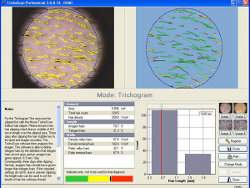
5) The test result remains in the patient database and can be used to compare with the control test after treatment.
The main advantages of using trichoscopy:
- the ability to determine the right form of baldness (diagnosis),
- assessment of hair density (number of hair / cm2), their size (μm), their growth rate (mm / day), determination of the percentage of hair in the anagen phase to the hair in the telogen phase,
- the possibility of finding a process of miniaturization, which is a characteristic feature of androgenetic alopecia in men and women,
- the possibility of comparison of trichoscopic images before and after the treatment of alopecia, repeated at regular intervals (eg every 6 months), which allows monitoring the progress of treatment and watching the reversal of miniaturization and full photocatalog of the patient,
- painless, non-invasive testing technique (no hair pulling).
3) Trichogram - hair test to assess whether the proportions of hair in the appropriate stages of growth are preserved. The disturbance of these proportions can be an indication for the doctor about the cause of the baldness. Normal hair percentage pattern:
- anagen: 85%
- catagen; < 1%
- telogen: 15%

Treatment scheme:
1) removing 2 samples of 30-50 hair from two areas of the scalp,
2) preparation of the preparation and microscopic assessment - on the basis of the characteristic of the phase of the cycle of the appearance of the roots of the hair, the number of hairs in individual stages is assessed.
Test defects:
1. For 2 weeks before the surgery, you must not carry out cosmetic treatments on the hair (eg dyeing).
2. Do not brush your hair for 5 days before the examination.
Androgen-induced alopeciaAndrogen-induced alopecia
1) features:
- in the blood increased androgen concentration, on the breast, disturbances of ovarian / adrenal / pituitary functions (eg polycystic ovary syndrome), - concerns women,
- clinical picture: middle-erectile alopecia, seborrhea, often hirsutism,
2) diagnostics:
- hormonal: prolactin (PRL), testosterone, dehydroepiandrosterone (DHEAS), sex hormone binding globulin (SHBG),
- trichogram / trichoscopy,
3) treatment: hormonal
- cyproterone acetate (e.g., Diane-35);
Androgenetic alopecia
1) features:
- normal androgen concentration in the blood,
- hypersensitivity of the hair follicles to androgens leading to the conversion of the end hair into the follicles, - concerns men and women,
- 2 patterns of baldness: male (acc.to Ludwig), female (acc. to Hamilton)
2) diagnostics:
- hormonal - without disorders, performed to differentiate and exclude baldness caused by androgens,
- trichogram / trichoscopy;
3) treatment:
a) men:
- minoxidil - in the form of 2 and 5% trimmers, in mesotherapy 0.5%,
- finasteride - effect on the enzyme converting testosterone to the active form,
- dietary supplements: iron, zinc, biotin;
- hair transplantation,
b) women:
- estrogen locally,
- minoxidil - in the form of 2 and 5% trimmers, in mesotherapy 0.5%,< /p>
- antiandrogens in oral hormonal contraception,
- dietary supplements: iron, zinc, biotin;
Alopecia areata
1) features:
- various intensities: from single points of baldness to hair loss all over the body,
- unknown causes (autoimmune disease?),
- in some patients, nail changes,
2) diagnostics:
- level of antibodies: antithyroid, antinuclear,
- trichogram / trichoscopy (presence of exclamatory hair),
3) treatment:
- if you can determine the causative factor,
- immunosuppressive: local and / or general,
- skin irritants,
- phototherapy,
- minoxidil;
Other forms of baldness
1) trichotillomania - habitual hair pulling, requires psychiatric treatment,
2) scarring - in the course of many systemic or dermatological diseases, causal treatment, in many cases immunosuppressive.
TREATMENT METHODS FOR TREATING THE ALOPECIA
Mesotherapy consists in applying directly to the skin of baldness substances that nourish the hair follicle and improve local circulation. Thanks to mesotherapy, you can significantly improve the nourishment of hair, stop hair loss and even regrow lost hair.
The treatment consists of a series of treatments:
- in the intensive phase (4-6 treatments) every 2 weeks,
- during the maintenance phase: initially every month, then every quarter;
Active substances used in alopecia mesotherapy:
1. Minoxidil - stimulates the hair follicles and keratinocytes. It accelerates the synthesis of glycosaminoglycans and the attachment of cysteine to the hair follicles, resulting in anagen prolongation (the period of hair growth).
2. Biotin - thanks to the content of sulfur molecules, it affects the healthy appearance of the skin, hair and nails. It regulates the activity of sebaceous and sweat glands. It is used to support the treatment of baldness and skin diseases (acne, seborrhea, dandruff).
3. Organic silica - is known for its regenerating properties of connective tissue. It is part of elastin, collagen and structural glycoproteins. At the tissue level, it induces fibroblast proliferation and promotes the regeneration of collagen fibers.
4. Dexpanthenol - organic acid, a product of pantothenic acid reduction (vitamin B5). The physiological significance of vitamin B5 is that it is a component of CoA. Coenzyme A affects the regeneration and nutrition of the hair structure.
5. Procaine – it works as antalgic, reduces bleeding during the procedure.
6. Mixtures of vitamins, microelements and other nutrients (NCTF, Dermaheal HL).Phototherapy - irradiation of the skin with ultraviolet light to induce an immunosuppressive effect in the skin covered by alopecia; particularly recommended in the case of alopecia areata.
Hair transplantation- recommended only in men in androgenetic alopecia.

